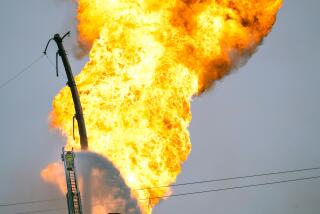Editorial: Say no to the Dakota Access Pipeline

Protesters have stood in the path of an oil pipeline that is under construction near the Standing Rock Sioux Reservation, which straddles North and South Dakota.
The U.S. government’s relationship with Native American tribes has been long, often duplicitous, and generally one-sided — which has cast a shadow of history over the weeks-long showdown in North Dakota over the 1,170-mile, $3.7-billion Dakota Access Pipeline. In recent months, protesters from the Standing Rock Sioux Tribe, as well as their supporters from around the country, have been confronted by private security forces with trained dogs, as well as police and National Guard troops. More than 400 people have been arrested amid allegations of abuse by law enforcement officers and counter-allegations of violence by protesters, who have been accused of heaving Molotov cocktails and torching cars. One report said a female protester fired three gunshots. And the protests are spreading; a dozen people were arrested in San Francisco on Monday.
The pipeline — designed to transport 470,000 barrels of oil a day from North Dakota to Illinois — has become a lightning rod for an array of issues, from historic tribal claims on the privately owned land through which the pipeline will run to the environmental risks of pipeline leaks to the wisdom of expanding the nation’s fossil-fuel infrastructure when the United States should be weaning itself from carbon-spewing fuels. And there is an underlay of social justice: An early proposal called for the pipeline to run north and upriver of the city of Bismarck, but that was changed in part over fears that a leak could harm the city’s water supply. So now the route runs just north and upriver of the Standing Rock reservation, and under a dammed stretch of the Missouri River from which the reservation draws its water — threatening the health of a less politically powerful, lower-income population.
Complaints that pipeline workers have already plowed up previously unrecognized sacred sites should be taken seriously.
The tribe sought an injunction against the continued construction of the pipeline, alleging that the federal government failed to follow proper procedures, including consulting with the tribe, before granting permits to let the pipeline cross waterways. But in September, a federal district court judge rejected the injunction, ruling that the tribe wasn’t likely to win its case, and that it had been offered ample opportunity to be a part of the planning process but failed to respond to overtures from the government. Left unchallenged in the tribe’s legal filing were the environmental threats a leak in the pipeline could pose to the water supply.
Native American tribes, including the Sioux, have clear historical causes for grievances against the federal government, including treaties that were approved and then violated. Complaints that pipeline workers have already plowed up previously unrecognized sacred sites should be taken seriously. More broadly, though, the environmental costs of continued reliance on fossil fuels are not only real, but the damage is already underway. The pipeline begins at the Bakken Formation in western North Dakota then angles southeastward through South Dakota, Iowa and into southern Illinois before tying into an existing pipeline network. Proponents of the pipeline argue that the oil it will carry will get to market even if the project is scuttled, transported by truck or rail, which they say carry more risk of environmental damage. But data show that while train and truck accidents might occur more often, pipeline breaks spill more oil and generally cause more damage to the environment by fouling groundwater and wilderness areas.
It’s hard to defend the actions of protesters blocking approved development projects on private property, but it’s easy to sympathize with their cause. The Army Corps of Engineers issued permits for the Dakota Pipeline despite warnings by the Environmental Protection Agency and two other federal agencies about possible environmental and safety issues.
When the tribe’s request for an injunction was turned down, the Obama administration issued an unusual statement saying that the Army Corps of Engineers would delay granting a permit to cross a strip of federal land and tunnel under the Missouri River “until it can determine whether it will need to reconsider any of its previous decisions” in approving the project. And Obama said Tuesday that the Army Corps is investigating “ways to re-route” the pipeline to take into account the tribal concerns.
The administration should go further and withhold the permit allowing the pipeline to cross the Missouri River. As the Los Angeles Times noted when President Obama rejected the Keystone XL pipeline, making it easier and cheaper to burn fossil fuels works against the world’s interest in confronting its biggest environmental threat.
Follow the Opinion section on Twitter @latimesopinion and Facebook
More to Read
A cure for the common opinion
Get thought-provoking perspectives with our weekly newsletter.
You may occasionally receive promotional content from the Los Angeles Times.










